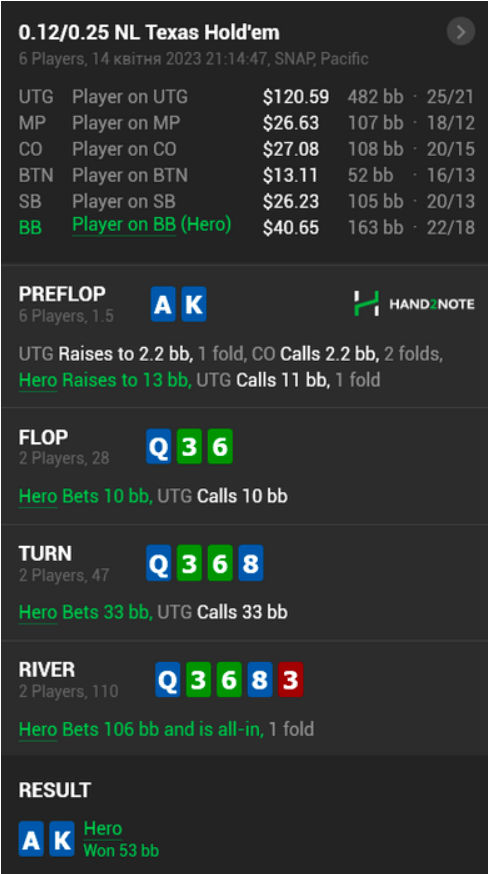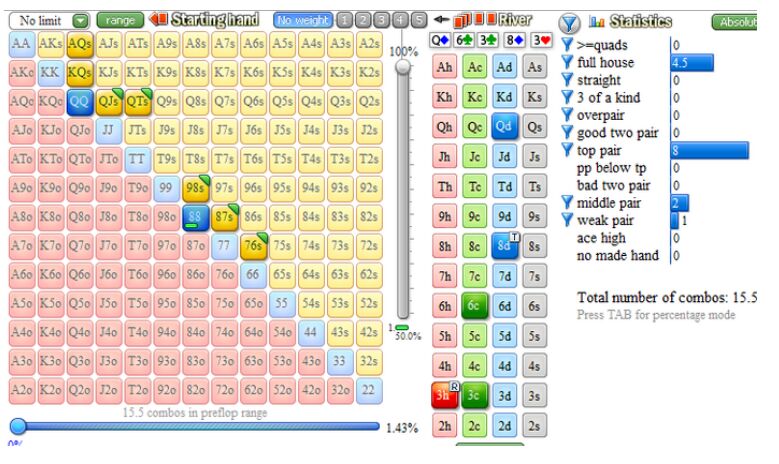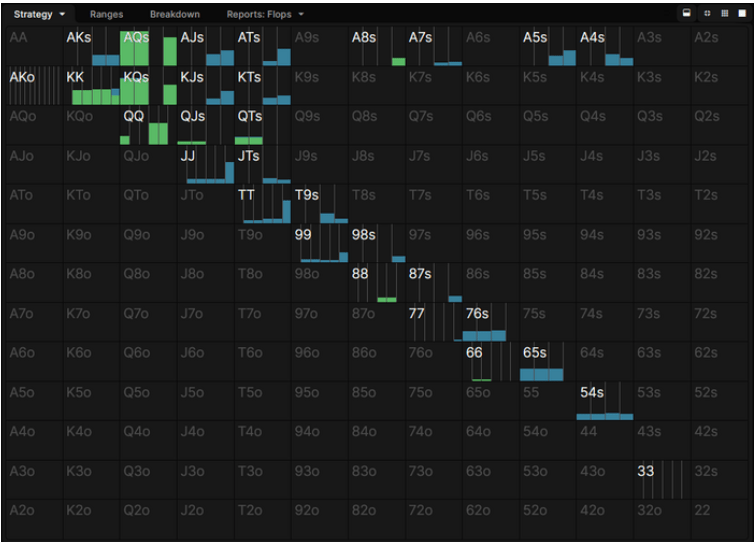Ilya Dusian sorted out the hand in deep stacks with NL25 in zoom, and coach Andrey Rustin checked whether he chose the right line and situation.

The hand was played in zoom on GGPoker.
Preflop
Nothing seems to raise questions here, except for the sizing, I think it was possible to charge with our hand and 14-14.5 bb, given that we have deep stacks with UTG.
Flop
I played like a standard zoom regular – bet about 1/3 and switched to another table. In the UTG range, here I have medium pockets, high suited connectors, as well as QQ, AQ, KQ, QJ, QT. The plan on the flop is to just see the turn card for less. I'm not likely to hit much here, except for suited connectors that didn't hit at all, and all sorts of backdoor gutshots like KJ and KT, and I'm blocking AJ diamonds. On the turn, we plan to turn on hard poker and start knocking out what beats me.
Turn
Our equity has gone down, we can start messing around. As for the size – 3/4 is probably a bit too much. If I were playing now, I would most likely bet somewhere around 28 bb – few people dare to raise us in a bluff anyway, and if the opponent continues to call JJ, TT, 99, then the ball is in their court.
River
The board pairs. Here, I think, we need to look at the opponent already, if this is a standard reg from the zoom, which is “unga-bunga, pair, I won’t fold!”, then pushing into a bluff is complete crap. And if the opponent here is capable of folding QT and QJ, then we are left, it seems, only against AQ, KQ and QQ, of which he can also fold half of KQ.
In general, everything seems normal, but I'm not sure. Judge strictly, I like it.
Trainer Analysis
Andrew Rustin
Trainer GT Pro Silver
Preflop
I completely agree with the preflop remark, in such deep stacks it is necessary to increase the sizing of the 3-bet and squeeze, 14-14.5 bb seems even small. I would bet 15bb.
Flop
I played like a standard zoom regular – bet about 1/3 and switched to another table. In the UTG range, here I have medium pockets, high suited connectors, as well as QQ, AQ, KQ, QJ, QT. The plan on the flop is to just see the turn card for less. I'm not likely to hit much here, except for suited connectors that didn't hit at all, and all sorts of backdoor gutshots like KJ and KT, and I'm blocking AJ diamonds. On the turn, we plan to turn on hard poker and start knocking out what beats me.
The game of a standard regular zoom is quite good. The opponent's range is outlined quite correctly, although due to the small size of the squeeze, I would add some connectors, and this is in our favor. The board suited our range well, better than our opponent, so it's quite possible to even range-bet for a third here.
Turn
Our equity has gone down, we can start messing around. As for the size – 3/4 is probably a bit too much. If I were playing now, I would most likely bet somewhere around 28 bb – few people dare to raise us in a bluff anyway, and if the opponent continues to call JJ, TT, 99, then the ball is in their court.
Such a turn card is really suitable for this. 3/4 is a good size, the river SPR will be 1, beautiful. If there is information on the opponent that he floats widely, then you can try to play check-push. Without notes, I would bet it myself.
River
The board pairs. Here, I think, we need to look at the opponent already, if this is a standard reg from the zoom, which is “unga-bunga, pair, I won’t fold!”, then pushing into a bluff is complete crap. And if the opponent here is capable of folding QT and QJ, then we are left, it seems, only against AQ, KQ and QQ, of which he can also fold half of KQ.
Good reasoning. On the river, after a big bet on the turn, we are up against a fairly transparent range of Qx and a flush draw or a flush draw+pair. The only question is whether the opponent is able to throw them away. With our bet, we give ~33% chance of a call.

If you don't give your opponent all sets with 88, and against the big blind they will quite possibly fold everything to a squeeze, then about half of the range on the river for combos will be full houses and AQ. If the opponent folds everything else, then the push is good.
It can be compared with the solver call range.

Here you can see that the solver says the preflop call has half of KK and, I think, a smaller number of connectors than a person will get. Also, the solver doesn't fold any Qx that made it to the river. On the human side, it looks like Villain will fold a lot more in a big BB pot against UTG, where both have tight ranges to begin with.
My opinion is that the hand was played well. The person who analyzed it adequately represents the ranges and is not afraid to bluff expensively.


